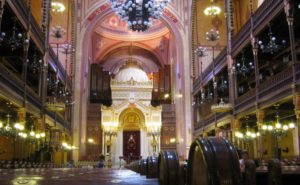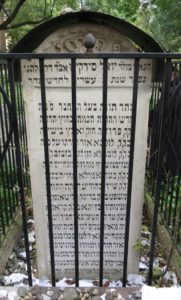This week we begin reading the third book of the Torah, Vayikra. In English, the book is called “Leviticus” because it is primarily concerned with the work of the Levites in the Temple. Among the Tribe of Levi were the kohanim, the “high priests”, direct descendants of Aaron. The kohanim were the ones who actually oversaw all the offerings in the Temple, facilitated atonement, and blessed the nation. The rest of the Levites, who were not kohanim, had other work to do. As is well-known, one of their main roles was to provide musical accompaniment in the Temple. Yet, the Torah never actually says this directly! How do we know?
We find later in the Tanakh many statements implying that the Levites played music in the Temple. For example, I Chronicles 9 lists the Levites and their various clans, and the work they did in the Temple. One of the groups were meshorerim, “singers”, who had no other duties except music, which they did “day and night” (v. 33). The Talmud (Arakhin 11a) finds proof from the Torah itself, which states that the Levite ‘“shall serve with the name of the Lord, his God.’ [Deuteronomy 18:7] What is this service performed with the name of God? You must say that this is song.” The Sages derive that serving with God’s name implies doing something that specifically uses and mentions God’s name, ie. singing the praises of God.
The Talmud goes on to give a number of other proofs from the Torah, followed by several proofs from other Biblical verses. For example, Psalms 82:3 says to “Take up the song, sound the timbrel, the melodious lyre and harp.” The verses that follow speak of things that were done on the Temple Mount, so the context implies that singing and instrumental music were performed there, too. Moreover, the verse here starts se’u (שאו) zimrah, implying that the verb se’u refers to something musical. This is the same verb used in Numbers 7:9 to describe the Levites carrying the various holy items in the Temple, which they “bore” (ישאו) upon their shoulders. Thus, the Torah itself was alluding to the Levite musical service.
We learn from the Talmud that Levite music was absolutely vital to the Temple services, and an offering that was not accompanied by music was invalid! (For more on the spiritual significance of music, see ‘The Kabbalah of Music and the Piano’.) The Talmud also debates whether it was the vocals that were more important or the instruments, and also discusses the types of musical instruments that the Levites used (Arakhin 10b). Among them were flutes and cymbals, as well as a special instrument called a magreifa. The Sages note that the Temple did not have the instrument called hydraulis.
The hydraulis was history’s first pipe organ and first keyboard instrument, probably invented in the 3rd century BCE by Ctesibius of Alexandria. It used the flow of water (carrying air), with a series of pipes, to produce sound, regulated by a keyboard. It later gave rise to the hydraulic organ (which may be the magreifa that the Talmud states was used in the Second Temple). The hydraulis would eventually evolve into what is now referred to as the church organ. The association of the organ with the church is so strong that when some synagogues started to feature them in the 19th century, it caused a stir in the Jewish world.
In 1865, a group of Orthodox leaders gathered in Michalowce (modern-day Slovakia, then part of the Hungarian Empire) to issue a set of new decrees to preserve traditional Judaism. One of their key points was that it was forbidden to enter a “choir-synagogue”, presumably one with an organ or other musical accompaniment. Probably not coincidentally, the assembly took place shortly after the grand opening of Europe’s newest and largest synagogue in 1859. This was the Great Synagogue of Budapest that featured, of course, a massive organ. (The little-known 1865 rabbinical assembly has since been considered the birthplace of Ultra-Orthodoxy, and the document the rabbis produced there has been referred to as “The Manifesto of Ultra-Orthodoxy”.)
This leads us to the big question: is a Jew permitted to listen to organ music? How about church music? Or, broader still, non-Jewish music of any kind?
Bach and Bach
For most of history, the question of non-Jewish music was not particularly pressing. After all, music could only be heard live, and performances were rare. If a person was to listen to music at all, it was either self-played or from some local musicians in one’s own town, usually at a wedding. (There is a whole separate discussion about the permissibility of going to a music party, which some of our Sages restricted due to the mourning over the Temple’s destruction and the difficult state of exile. Weddings were an exception.) Jews generally lived amongst themselves, in Jewish villages or in the Jewish quarters of cities. There were few opportunities for Jews to listen to “non-Jewish music”.
The renaissance started to change that. A revival of the arts meant that music was becoming more and more common. Soon enough, musicians played large concerts for the general public. Meanwhile, the authorities gradually relaxed restrictions on Jews, allowing them to participate in broader society. Suddenly, the question of non-Jewish music for Jews became pertinent.
One of the key figures in the evolution of music and its opening to the wider masses is Johann Sebastian Bach (1685-1750). He wrote music not just for the private audiences of royalty, but also for local churches and universities. Bach was primarily an organist, and generally wrote music with religious overtones that was meant to be spiritually uplifting. In fact, Bach was described as having written the “soundtrack” to the Bible, and was sometimes called “God’s composer”. (Click here to listen to Bach’s introduction to what would be his soundtrack for the “Old Testament”.) Although not as famous in his own lifetime, the “Bach Revival” of the 19th century made him a household name. Pretty much everyone loved his music, Jews included. Could Jews listen to Bach?
Thankfully, the Jewish people had a J.S. Bach of our own who, several decades before the musician J.S. Bach appeared (lehavdil), already answered that question. Rabbi Joel Sirkis “Bach” (1561-1640) was born in Lublin, Poland, the scion of a long line of rabbis. In 1631, he wrote Bayit Chadash, his masterpiece of a commentary on the law code of Rabbi Yaakov ben Asher (the Ba’al HaTurim, 1269-1343). As with many other sages, Rav Sirkis was referred to by his work, the Bayit Chadash, or in short, “Bach”. Several of his other works have survived, including his responsa. In Shu”t haBach HaYeshanot (#127), the Bach answers that listening to non-Jewish music that is devoid of any religious or idolatrous significance is permissible.
This answer of the Bach is cited by the Mishnah Berurah (53:82) in a discussion about what disqualifies a chazzan. The Shulchan Arukh (Orach Chaim 53:25) notes that a chazzan is removed from his position when a disqualification is found in him. The Rema comments that one of the disqualifying features is if the chazzan sings non-Jewish tunes. On this, the Mishnah Berurah cites the Bach in saying that it is only forbidden if the intent is idolatrous. Otherwise, it is permitted. The Bach permitted* even music originally composed for church, as long as it is enjoyed by the general public, too, and not specifically associated with any Christian ritual.
That means that a Jew is permitted to listen to the compositions of Bach (Johann Sebastian, that is), since they are enjoyed by the general public and are not specifically tied to any ritual, even though they may have been composed with religious sentiments in mind. The same is true for any music of non-Jewish origin. Having said that, the “vibe” and meaning of the music is a vital consideration to have in mind. Music that is violent, licentious, or angry (like much of rap and heavy metal) is not something a Jew—or anyone else, for that matter—should be listening to. Music that is soothing, uplifting, positive, with appropriate lyrics, is a good thing.
Multiple studies have shown how music affects a person’s thoughts and emotions. For instance, a 2003 study by researchers from Iowa State University and the Texas Department of Human Services compared the effects of violent and non-violent music on 500 college students. The results were clear: violent music led to more aggressive thoughts and emotions. (The paper, published in the Journal of Personality and Social Psychology, also notes other studies done previously on the subject that bring further proof).
Relatedly, the Talmud (Chagigah 15b) states that the reason Elisha ben Avuya became a heretic is because “Greek music never ceased from his mouth.” He listened to Greek music, with its idolatrous lyrics and overtones, and eventually became a Hellenist himself. Undoubtedly, music and lyrics influence a person (if not directly, then subliminally). This is why it is all the more important to listen to the right music.
It may be worth noting here that the composer who led the “Bach Revival” in the 19th century was none other than Felix Mendelssohn (1809-1847), grandson of Moses Mendelssohn (1729-1786), often considered the father of the Haskalah and Reform Judaism. Felix was baptized as a child and raised by his parents as a Christian. Altogether, five of Moses Mendelssohn’s six children converted to Christianity! I don’t think music specifically had much to do with it, but that little fact does highlight the Jewish world’s struggle with assimilation.
So, we can certainly understand why the Orthodox world today generally frowns upon non-Jewish music. We can also understand the rabbis that gathered in 1865 to decree that no synagogue should have any kind of non-Jewish-style musical accompaniment. They were genuinely concerned about the preservation of traditional Judaism. Thankfully, there is no shortage of good Jewish and Hebrew music today. And, hopefully, we will soon merit to hear the original spiritual tunes that resonated through the Temple millennia ago.
The above essay is adapted from Garments of Light, Volume Three.
Get the book here!
* When first writing this essay, I spent hours unsuccessfully searching for the Bach’s responsa 127, the one that discusses music and is cited by the Mishnah Berurah. The version of the Shu”t on HebrewBooks.org abruptly ends at responsa 110. Another version I was able to find discusses something else at responsa 127. The Chafetz Chaim obviously had a different responsa 127, which he cited in his Mishnah Berurah. I could not find any reference to music anywhere in the complete Shu”t I found; it seems to have been excised! Who censored the Bach? Rabbi Eli Shochet, who wrote an extensive biography of the Bach, explains that it was censored by Christian authorities, who removed any reference to Christianity or churches, even when the references were benign (such as permitting church music). Nonetheless, it seems that the Chafetz Chaim did have an original, uncensored version of the text. The original version is available in print form today. Huge credit to Shlomo Slatus for sending me the page from his own collection:





Pingback: Music on Shabbat and in the Temple | Mayim Achronim